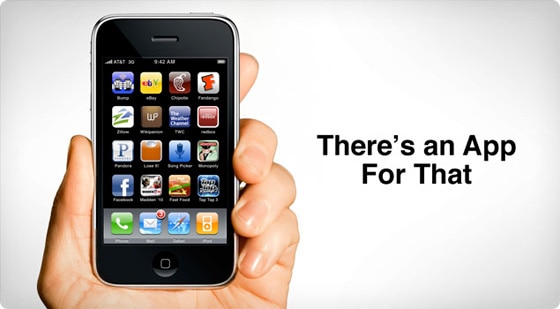
“There’s an app for that.”
Actually, there’s more than one app for that now. And that’s the problem.
With over 700,000 apps battling for attention in the App Store, the stress isn’t just on consumers trying to discover the best apps, it’s on marketers trying to get their apps discovered. App Claustrophobia is on it’s way into the DSM IV – just you wait.
The struggle with App Store discovery
If you’re an app publisher you may have heard of the latest changes to the App Store. The short version is that iOS 6 is killing App Store discovery.
Let’s take a quick glimpse at how search has changed within the App Store from iOS 5 to iOS 6, using “Stocks” as a keyword example:
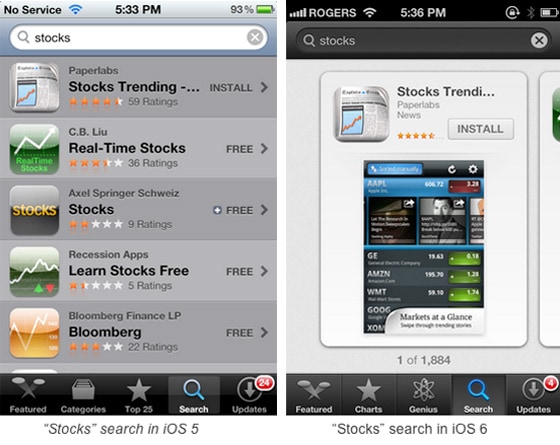
That’s five results to one.
Is your app feeling the squeeze? If not, expect claustrophobia to set in soon.
The struggle to get paid: App Store Revenue Distribution
Alright, so getting found can be pretty tough. But can you still make decent money if you’re not the number one search result? Here’s a look at revenue distribution in the iOS games category:
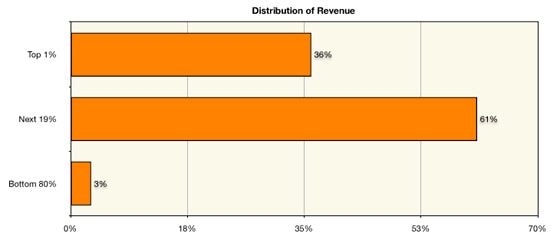
The top 20% of apps make 97% of the revenues. The creator of this survey will be the first to note that these results should not be taken as statistically significant. Regardless, you could skew these numbers to the low side with significant intensity and the picture would still be clear.
Lesson learned: if you want to make major dough, you need to be sitting at the top of the App Store charts.
But what has to come first: big download numbers or a solid chart ranking? And how do you get there if Apple won’t help?
Taking your marketing beyond the App Store
Trying to climb the charts from the inside using App Store optimization techniques is quickly becoming a fool’s game.
Apps are a multi billion dollar industry, and discovery is the key. The thing is, Apple wants what’s going to get Apple more money, so If you’re not already sitting pretty at the top of the charts with some sexy download numbers, you have some work to do.
It’s time to put the ball in your court and build-out your app’s web presence.
Step 1 – Create a home for your app on the web
Whether you’ve built a website for your app or not, like the battery to your smartphone, landing pages are a critical piece to your inbound marketing. They allow you to focus your messaging toward a very specific group of people while persuading them to carry out a very specific goal – your call to action. In this case, probably an app store button.
If you don’t have a website for your app yet, no sweat. A landing page can help you showcase your app on the open web, before your website is ready. Lucky for you, Unbounce has some great mobile app templates ready to get you started.
The time has come to create a landing page for your app.
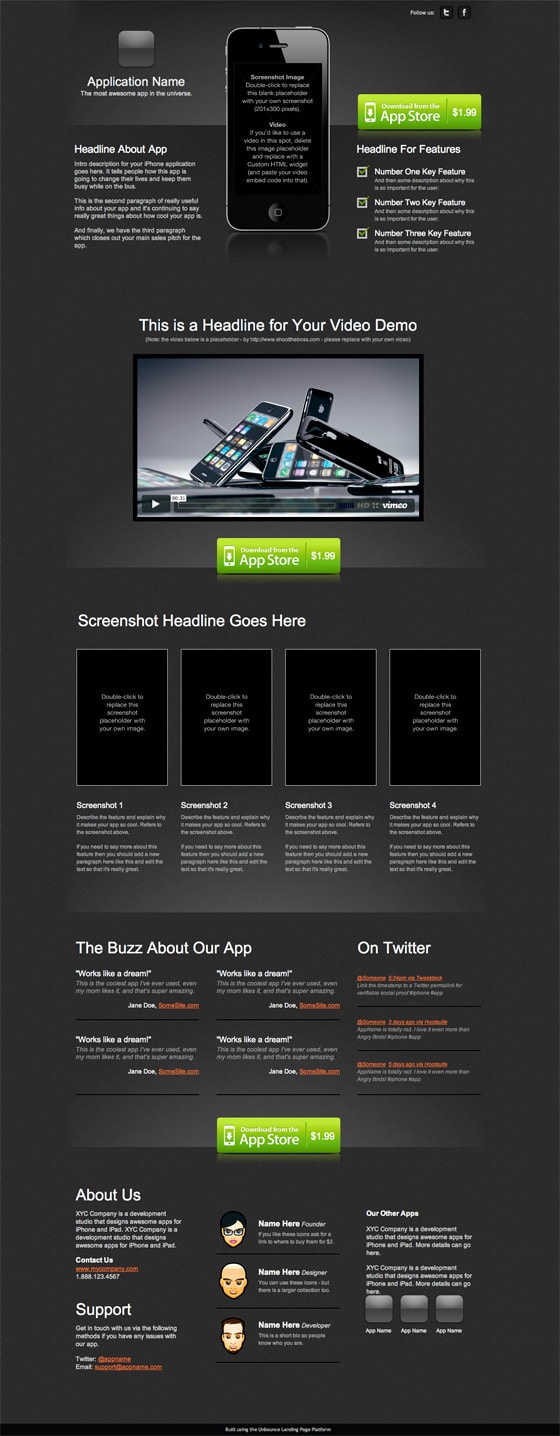
The trick is to showcase your app better than Apple can
The App Store has all sorts of limitations, but you (and your landing pages) are better than that. To get started, below is a list of what the App Store offers in terms of marketability for your app, and some suggestions to make your app’s landing page sing.

It’s clear that Cinemagram’s landing page is way more effective at instantly selling you the idea – and that’s just with a simple landing page. There are way more levels you can touch on where Apple holds you back:
- Page design
- Sales copy
- Large images and adding context to screenshots
- Video
- UI animations
- Showcasing social proof like testimonials and press coverage
But wouldn’t this lower my installation rate, you say?
Well, glad you asked! You can actually INCREASE your installation rate with a good landing page, despite the fact you added another step for your potential customer to click-through. The key is that your landing page is doing a better job of PRE-SELLING your app, so when customers click over to your app store page they’re just looking for the Download button.
And the best part about all of this… wait for it… you can now A/B split test your pages to see which are converting the best, find your winners, drill down to make more specific tweaks and optimize them for peak performance.
Step 2 – Start driving traffic to your landing page
This section could be a novel on it’s own, but here’s the main idea:
You have two major options: pay for traffic or work on getting organic traffic
Paid Traffic
Paying for traffic isn’t as sexy as roping in organic traffic with inbound marketing – which we’ll talk about below – however, it’s incredibly useful. So, when should you use it?
Paying for traffic is a great short term strategy to test your marketing because it’s almost instantaneous. Even with a low budget, you can likely drive enough traffic to test your landing pages. Just remember to set a low limit to your daily ad spend.
Paid traffic can also work wonders in the long term once you know your customer lifetime value (LTV). As long as you keep your cost of customer acquisition (CoCA) a healthy amount lower than your LTV, you can throw money at acquiring users through paid channels, since you’ll make it back in the future. Just be sure your cash flow doesn’t dip too low.
Some examples of paid channels:
- Mobile networks, like AdMob and iAds
- Web networks, like Google AdWords
- Web retargeting via AdWords or networks like Perfect Audience
- Facebook Ads and promoted posts offer a highly targeted solution
- Premium networks like The Deck and Fusion Ads to reach tech enthusiasts
- StumbleUpon for general interest apps
- Twitter Ads can be really effective for app developers, pay only for engagement
Sponsorships are also a solid option. You can buy an ad spot on a blog, podcast or video and support a content producer in your niche. Do some research, think long-tail and avoid the big names in your vertical. The iPadFan.com is a great example of a highly engaged audience with an active mailing list.
Organic Traffic
Inbound marketing is what everyone’s talking about, and it’s what drives your organic, non-paid, traffic. It’s not a new concept, but due to improvements in web analytics, people are now seeing phenomenal results – at least when it’s executed well.
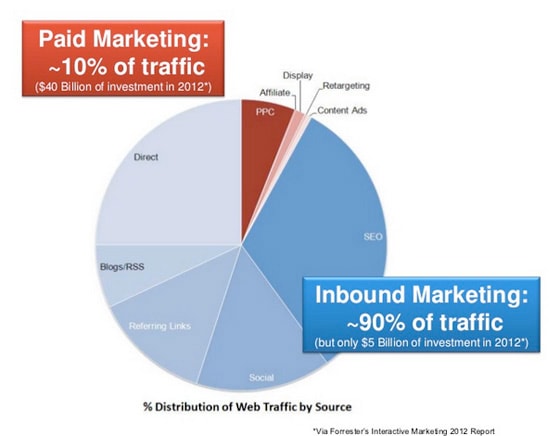
According to Forrester’s research, nicely presented here by SEOmoz, 90% of web traffic is from inbound marketing. Not only that, but mobile web use is now bigger than desktop web use for the first time in history. Now that should be music to your ears, from the playlist called opportunity.
The simple idea behind inbound marketing is to offer someone a lollipop instead of splashing product in their face. Usually this is done by creating informative and useful content that educates people. Those people then become more exposed to you and your ideas, creating a sense of familiarity, likability and trust. Here are some examples of inbound channels:

The one downfall of driving inbound or “organic” traffic is that it is an extremely time consuming strategy due to the time and people power it takes to create awesome content. That said, it’s worth every drop of sweat for the long term.
Note: even though you’re not directly paying for traffic, inbound marketing still costs money. Your employee’s spend time creating content and orchestrating it’s distribution, in exchange for organic SEO results that will (hopefully) drive traffic well into the future.
The key to making the right marketing decisions, regardless of if the traffic is being paid for or organic, is knowing your audience – how they act and where they like to hang out. Place your ads on a relevant blog that has a need or desire for what you’ve created, and likewise, create content that speaks to your audience and helps them solve a problem.
The only way to really discover your audience is to test, test, test.
Step 3 – Measure the success of your app’s landing page
The final piece, of course, is knowing how well your landing pages actually convert into app downloads.
Unbounce conversion tracking can help when you deliver a SaaS or a digital product outside of an app store. But sadly, if you’re selling an app, it’s not so simple.
App stores block all conversion data from reaching you, killing your ability to know which landing page is driving the bulk of your sales. This is where Tapstream comes in.
A simple JavaScript snippet inserted into your landing page’s JavaScript field in Unbounce will ensure that visitors are automatically tracked as customers once they run your app – showing you true conversion numbers. Note: a small SDK is also required in the app.
Create as many landing page variants as you like for your testing. As long as the JavaScript snippet is included, Tapstream will show you which landing page is converting the most visitors into app downloads.
Could you be increasing your sales?
Give Tapstream’s free 45 day trial a shot, and enter “UNBOUNCE20” upon sign-up. If you enjoy the service and stick around after your trial, you’ll automatically receive 20% off your first 6 months.
